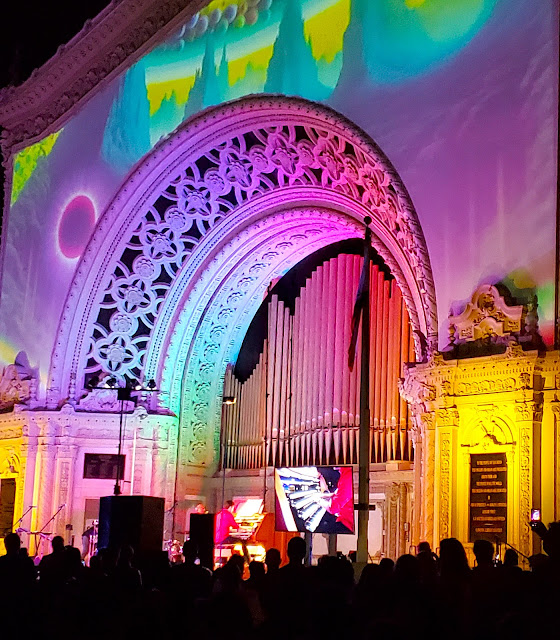Balboa Park is one of the great attractions of San Diego. In addition to its world-class San Diego Zoo, the Comic-con Museum, the San Diego Automotive Museum, several art and other museums, its Spanish Village artisan market, and its amazing gardens, it also has what is called the world's largest outdoor musical instrument, the Spreckels Organ. A video offers a great introduction to this amazing 110-year-old instrument, which is supported by the city and by its own Spreckels Organ Society.
These days, the primary organist is Raul Prieto Ramirez, who holds the title Civic Organist. Guest organists appear often too, either at the every-Sunday-at-2pm-rain-or-shine concerts or at special events, such as an evening concert around Halloween with old silent horror movies (if anything with Buster Keaton or Stan Laurel could be considered a horror movie) and the organ providing the musical soundtrack. All performances, even those with movies, are free, and the many benches almost guarantee everyone a seat.
The last two of the summer 2024 Monday evening concerts were the Buster Keaton movie "Steamboat Bill Jr." with David Marsh on the organ, and, on Labor Day, Raul Ramirez's performance of music by the Doors and Pink Floyd accompained by the Spreckels Organ Pavillion's own rock band, the Organization. We went to both and each was amazing. The organ can toot like a steamboat, honk like a car and provide almost any sort of sound effect along with the musical score that movies need. The rock concert opened with the organ intro to "Light My Fire" and only got better. The band's vocalists hit the right notes and struck the right attitudes. And "Shine on You Crazy Diamond" made full use of the organ's range and volume. A light show was customized for each number; for example, stacks of bills and floods of coins tumbled down the front of the pavillion during Pink Floyd's "Money."
It's worth noting that the organ has no electronic amplification. All the sounds are "real." The drum? There's a real drum inside with the pipes and it is mechnically struck as needed. Cymbals, too. There are also a glockenspiel, chimes and bells. All controlled from the organ's keyboard or footpedals. A walk-in wind chest is the heart and lungs of the whole thing.
On a September 2024 Saturday morning, we joined about a hundred other organ afficiandos for a brunch on the pavillion's stage, a presentation on how the organ works, a brief concert (Queen's "Bohemian Rhapsody" was a highlight, along with Mussorgsky's "Great Gates of Kiev") and a tour inside the organ itself. This was a fund-raiser for the Organ Society.
The links at the beginning of this post tell and show you much more about the organ than I can. The video also lets you hear the organ; this platform allows only very brief audio-video. Here are a few photos:
 |
| The organ console is moved from the pavillion to the open-air stage for performances. |
 |
| Leather bellows such as this power the organ. Collectively these bellows are called "the leathers" and are due for replacement at a cost of a quarter-million dollars. |
 |
| Almost all of the organ's more than 5,000 pipes are hidden in the pavillion. |
 |
| When the organist wants the sound of a snare drum, this produces it. |
 |
| Cololnnades reach out from both sides of the organ pavillion to partially surround the seating area. During concerts, passers-by stop to listen in the area where these people are. |




No comments:
Post a Comment